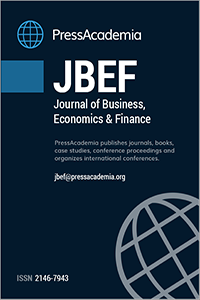Abstract
References
- Cengel, O. (2006). Emerging marketing techniques in the real estate sector and current implications. İstanbul Ticaret Üniversitesi Sosyal Bilimler Dergisi, 5(9), 125-131.
- Chin, H. C., Quddus, M. A. (2003). Modeling count data with excess zeroes – an empirical application to traffic accidents. Sociological Methods & Research, 32(1), 90–116.
- Cizmeci, F., Ercan, T. (2015). The effect of digital marketing communication tools in the creation brand awareness by housing companies. Megaron, 10(2), 149-161.
- Kerby, D. S. (2014). The Simple Difference Formula: An Approach to Teaching Nonparametric Correlation 1. Comprehensive Psychology, 3(11).
- Komurlu, R. et al. (2013). Drivers of residential developers’ marketing strategies based on buyer preferences. METU Journal of the Faculty of Architecture, 30(2), 1-16.
- Miles, M., Berens, G. and Weiss, M. (2001), Real Estate Development: Principles and Process, Urban Land Institute, Washington, DC
- Pesaran, H. Hashem, and Yongcheol Shin. (1998). Generalized impulse response analysis in linear multivariate models. Economics letters, 58(1), 17-29.
- Polat, S., Ferman, M. (2015). An analysis of factors affecting understanding and applications of branded housing project marketing around the Istanbul metropolitan area. Journal of Management, Marketing and Logistics, 2(1), 24-36.
- PWC, (2015, February) The World in 2050.
- Stigler, S. M. (1989). Francis Galton's Account of the Invention of Correlation. Statistical Science, 4(2), 73–79
- Terri, T. (2003). Fair Housing Marketing Strategy and Materials Development, Request for Proposals, Arizona Department of Housing, Phoenix, AZ.
- TUIK (Turkish Statistical Institute). House Sales Statistics. Retrieved form http://www.tuik.gov.tr/PreTablo.do?alt_id=1056.
- TUIK (Turkish Statistical Institute). Household Stats. Retrieved from http://www.tuik.gov.tr/PreHaberBultenleri.do?id=18624.
- TUIK (Turkish Statistical Institute). Population Stats. Retrieved from http://www.tuik.gov.tr/PreHaberBultenleri.do?id=18616.
- TUIK Retrieved from https://biruni.tuik.gov.tr/gosterge/?locale=en.
- TUIK Retrieved from http://web.archive.org/web/20160104210603
- Worldbank, Statistics about Turkey. Retrieved from http://data.worldbank.org/country/turkey.
- Zeileis, A., Kleiber, C. and Jackman, S. (2008). Regression Models for Count Data in R, Journal of Statistical Software, July 2008, Volume 27, Issue 8:1-25.
- Zivot, E. and Jiahui, W. (2006). Vector autoregressive models for multivariate time series. Modeling Financial Time Series with S-Plus®, 385-429.
Abstract
References
- Cengel, O. (2006). Emerging marketing techniques in the real estate sector and current implications. İstanbul Ticaret Üniversitesi Sosyal Bilimler Dergisi, 5(9), 125-131.
- Chin, H. C., Quddus, M. A. (2003). Modeling count data with excess zeroes – an empirical application to traffic accidents. Sociological Methods & Research, 32(1), 90–116.
- Cizmeci, F., Ercan, T. (2015). The effect of digital marketing communication tools in the creation brand awareness by housing companies. Megaron, 10(2), 149-161.
- Kerby, D. S. (2014). The Simple Difference Formula: An Approach to Teaching Nonparametric Correlation 1. Comprehensive Psychology, 3(11).
- Komurlu, R. et al. (2013). Drivers of residential developers’ marketing strategies based on buyer preferences. METU Journal of the Faculty of Architecture, 30(2), 1-16.
- Miles, M., Berens, G. and Weiss, M. (2001), Real Estate Development: Principles and Process, Urban Land Institute, Washington, DC
- Pesaran, H. Hashem, and Yongcheol Shin. (1998). Generalized impulse response analysis in linear multivariate models. Economics letters, 58(1), 17-29.
- Polat, S., Ferman, M. (2015). An analysis of factors affecting understanding and applications of branded housing project marketing around the Istanbul metropolitan area. Journal of Management, Marketing and Logistics, 2(1), 24-36.
- PWC, (2015, February) The World in 2050.
- Stigler, S. M. (1989). Francis Galton's Account of the Invention of Correlation. Statistical Science, 4(2), 73–79
- Terri, T. (2003). Fair Housing Marketing Strategy and Materials Development, Request for Proposals, Arizona Department of Housing, Phoenix, AZ.
- TUIK (Turkish Statistical Institute). House Sales Statistics. Retrieved form http://www.tuik.gov.tr/PreTablo.do?alt_id=1056.
- TUIK (Turkish Statistical Institute). Household Stats. Retrieved from http://www.tuik.gov.tr/PreHaberBultenleri.do?id=18624.
- TUIK (Turkish Statistical Institute). Population Stats. Retrieved from http://www.tuik.gov.tr/PreHaberBultenleri.do?id=18616.
- TUIK Retrieved from https://biruni.tuik.gov.tr/gosterge/?locale=en.
- TUIK Retrieved from http://web.archive.org/web/20160104210603
- Worldbank, Statistics about Turkey. Retrieved from http://data.worldbank.org/country/turkey.
- Zeileis, A., Kleiber, C. and Jackman, S. (2008). Regression Models for Count Data in R, Journal of Statistical Software, July 2008, Volume 27, Issue 8:1-25.
- Zivot, E. and Jiahui, W. (2006). Vector autoregressive models for multivariate time series. Modeling Financial Time Series with S-Plus®, 385-429.
Details
| Primary Language | English |
|---|---|
| Subjects | Finance |
| Journal Section | Articles |
| Authors | |
| Publication Date | June 30, 2019 |
| Published in Issue | Year 2019 Volume: 8 Issue: 2 |
Journal of Business, Economics and Finance (JBEF) is a scientific, academic, double blind peer-reviewed, semi-annual and open-access journal. The publication language is English. The journal publishes 2 issues a year. The issuing months are June and December. The journal aims to provide a research source for all practitioners, policy makers and researchers working in the areas of business, economics and finance. The Editor of JBEF invites all manuscripts that that cover theoretical and/or applied researches on topics related to the interest areas of the Journal. JBEF charges no submission or publication fee.
Ethics
Policy - JBEF applies the standards of
Committee on Publication Ethics (COPE). JBEF is committed to the academic
community ensuring ethics and quality of manuscripts in publications.
Plagiarism is strictly forbidden and the manuscripts found to be plagiarized
will not be accepted or if published will be removed from the publication. Authors
must certify that their manuscripts are their original work. Plagiarism,
duplicate, data fabrication and redundant publications are forbidden. The
manuscripts are subject to plagiarism check by iThenticate or similar. All manuscript submissions must provide a similarity report (up to 15% excluding quotes, bibliography, abstract, method).
Open Access - All research articles published in PressAcademia Journals are fully open access; immediately freely available to read, download and share. Articles are published under the terms of a Creative Commons license which permits use, distribution and reproduction in any medium, provided the original work is properly cited. Open access is a property of individual works, not necessarily journals or publishers. Community standards, rather than copyright law, will continue to provide the mechanism for enforcement of proper attribution and responsible use of the published work, as they do now.

